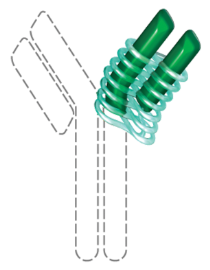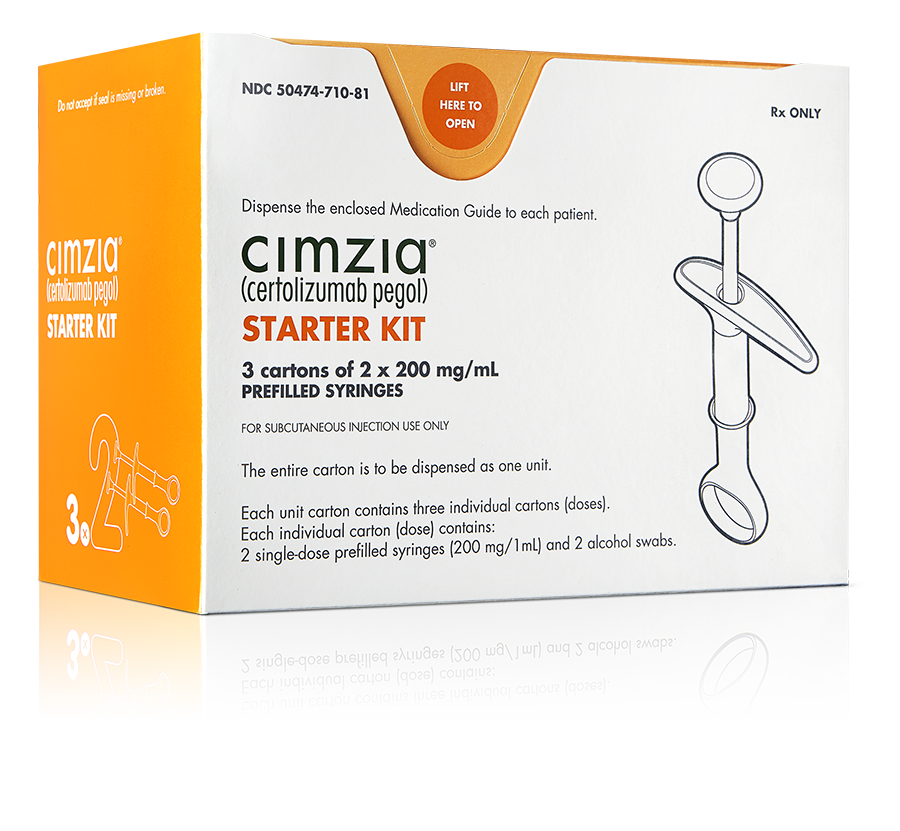Proven efficacy in joints that lasts – regardless of prior biologic experience2,5
Sustained improvement in joint pain and stiffness due to psoriatic arthritis
Important Safety Information
Serious and sometimes fatal side effects have been reported
with CIMZIA, including tuberculosis (TB), bacterial sepsis,
invasive fungal infections (such as histoplasmosis), and
infections due to other opportunistic pathogens (such as
Legionella or Listeria). Patients should be closely monitored
for the signs and symptoms of infection during and after
treatment with CIMZIA. Lymphoma and other malignancies, some
fatal, have been reported in children and adolescent patients
treated with TNF blockers, of which CIMZIA is a member. CIMZIA
is not indicated for use in pediatric patients.
CIMZIA is contraindicated in patients with a
history of hypersensitivity reaction to certolizumab pegol or to
any of the excipients. Reactions have included angioedema,
anaphylaxis, serum sickness, and urticaria.
Please
see additional Important Safety Information continued on the
following pages. Full Prescribing Information can be found
here.
CIMZIA®
(certolizumab pegol):
Joint-symptom relief that lasts
Limitation of OLE: ACR responder rates did not have a long-term placebo comparator beyond Week 24.
The ACR response criteria assess changes in swollen and
tender joints, pain, functional ability, patient and
physician assessment, and acute phase reactant.6
ACR20/50/70, American College of Rheumatology
criteria for 20%-50%-70% response; NRI, nonresponder
imputation; OLE, Open open-label extension; PsA, psoriatic
arthritis; Q2W, every 2 weeks.
aRS-NRI: Randomized set nonresponder imputation.
bAll CIMZIA patients received a loading dose of 400 mg at
Weeks 0, 2, 4.
Important Safety Information
CIMZIA is contraindicated in patients with a history
of hypersensitivity reaction to certolizumab pegol or to any
of the excipients. Reactions have included angioedema,
anaphylaxis, serum sickness, and urticaria.
Please
see additional Important Safety Information continued on the
following pages. Full Prescribing Information can be found here.
Prevent the progression of joint damage
Lasting inhibition of joint damage
of patients assessed radiographically experienced no progression of joint damage over 4 years (CIMZIA 200 mg Q2W; n=98).6a The remainder experienced minimal progression.
Patients treated with CIMZIA 400 mg Q4W did not demonstrate greater inhibition of radiographic progression compared with placebo-treated patients at Week 24. The radiographic primary end point was changed from baseline in mTSS at Week 24 [–0.02 with CIMZIA 200 mg Q2W (n=138) vs. 0.18 with placebo (n=136)].1,5
Open-label extension (OLE) limitation: Weeks 48 through 216 were an OLE phase of the study. As with any long-term, uncontrolled OLE, there were several limitations with this portion of the study.
IL, interleukin; mTSS, modified Total Sharp Score; PsA,
psoriatic arthritis; Q2W, every 2 weeks; Q4W, every 4 weeks;
TNF, tumor necrosis factor.
a“No progression” was defined as a change from baseline in
mTSS of ≤0.5. When “no progression” was defined as a change
from baseline in mTSS of ≤0, 63.3% of x-rayed patients
experienced no progression.6
bInformation
presented here is specific to the use of anti-TNFs; refer to
complete ACR/NPF Guidelines for the Treatment of Psoriatic
Arthritis for greater context. For patients with severe skin
involvement, anti-IL-17 therapy may be considered.
Important Safety Information
Serious and sometimes fatal side effects have been reported
with CIMZIA, including tuberculosis (TB), bacterial sepsis,
invasive fungal infections (such as histoplasmosis), and
infections due to other opportunistic pathogens (such as
Legionella or Listeria). Patients should be closely
monitored for the signs and symptoms of infection during and
after treatment with CIMZIA. Lymphoma and other
malignancies, some fatal, have been reported in children and
adolescent patients treated with TNF blockers, of which
CIMZIA is a member. CIMZIA is not indicated for use in
pediatric patients.
Please see additional Important Safety
Information continued on the following pages. Full Prescribing
Information can be found
here.
The 2018 American College of Rheumatology/National Psoriasis Foundation (ACR/NPF) Guidelines for the Treatment of Psoriatic Arthritis Recommend Anti-TNF Therapy as7b:
FIRST-LINE OPTION
For treatment-naïve patients with active PsA
SECOND-LINE OPTION
For patients with active PsA despite therapy with another anti-TNF or oral medication
For patients with active PsA despite anti-IL-17 or anti-IL-12/23 therapy
IL, interleukin; mTSS, modified Total Sharp Score; PsA,
psoriatic arthritis; Q2W, every 2 weeks; Q4W, every 4 weeks;
TNF, tumor necrosis factor.
a“No progression” was defined as a change from baseline in
mTSS of ≤0.5. When “no progression” was defined as a change
from baseline in mTSS of ≤0, 63.3% of x-rayed patients
experienced no progression.6
bInformation presented
here is specific to the use of anti-TNFs; refer to complete
ACR/NPF Guidelines for the Treatment of Psoriatic Arthritis
for greater context. For patients with severe skin
involvement, anti-IL-17 therapy may be considered.
Important Safety Information
Serious and sometimes fatal side effects have been reported
with CIMZIA, including tuberculosis (TB), bacterial sepsis,
invasive fungal infections (such as histoplasmosis), and
infections due to other opportunistic pathogens (such as
Legionella or Listeria). Patients should be closely
monitored for the signs and symptoms of infection during and
after treatment with CIMZIA. Lymphoma and other
malignancies, some fatal, have been reported in children and
adolescent patients treated with TNF blockers, of which
CIMZIA is a member. CIMZIA is not indicated for use in
pediatric patients.
Anaphylaxis or serious allergic reactions may
occur. Some of these reactions occurred after the first
administration of CIMZIA. Hypersensitivity reactions have been
reported rarely following CIMZIA administration. The needle
shield inside the removable cap of the CIMZIA prefilled
syringe contains a derivative of natural rubber latex which
may cause an allergic reaction in individuals sensitive to
latex.
Please see additional Important Safety
Information continued on the following pages. Full Prescribing
Information can be found here.
Long-term relief of joint pain and stiffness regardless of prior biologic use
Limitation of OLE: ACR responder rates did not have a long-term placebo comparator beyond Week 24.
aRandomized set.
Nonresponder imputation.
bCIMZIA combined dose included patients receiving CIMZIA
200 mg Q2W and patients receiving CIMZIA 400 mg Q4W.
ACR20/50/70, American College of Rheumatology criteria for
20%-50%-70% response; PsA, psoriatic arthritis; Q2W, every
2 weeks; Q4W, every 4 weeks; TNF, tumor necrosis
factor.
aRandomized
set. Nonresponder imputation.
bCIMZIA combined dose included patients receiving CIMZIA
200 mg Q2W and patients receiving CIMZIA 400 mg Q4W.
Important Safety Information
Cases of lymphoma and other malignancies have been
observed among patients receiving TNF blockers, including
children, adolescents, and young adults. Acute and chronic
cases of leukemia have also been reported. Post marketing
cases of hepatosplenic T-cell lymphoma (HSTCL), a rare type
of T-cell lymphoma that has a very aggressive disease course
and is usually fatal, have been reported in patients treated
with TNF blockers, including CIMZIA. Melanoma and Merkel
cell carcinoma have been reported in patients treated with
TNF-antagonists, including CIMZIA. Periodic skin
examinations are recommended for all patients, particularly
those with risk factors for skin cancer.
Please
see additional Important Safety Information continued on the
following pages. Full Prescribing Information can be found here.
Proven efficacy in joints that lasts– regardless of prior biologic experience1,5,6
CIMZIA provides powerful symptom relief even with previous biologic use
Anti-TNF-experienced
CIMZIA combined dose (n=54)c
In the placebo group (n=26), patients achieved ACR 20/50/70 rates of 12%, 4% and 4%, respectively.
Anti-TNF-naïve
CIMZIA combined dose (n=219)c
In the placebo group (n=110), patients achieved ACR 20/50/70 rates of 26%, 15% and 5%, respectively.
The primary efficacy end point for Study PsA001 was
ACR20 response at Week 12.
aRandomized set.
Nonresponder imputation.
bACR20 response rates were stratified by baseline prior
TNF inhibitor exposure, which was a prespecified secondary
end point.
Important Safety Information
Serious and sometimes fatal side effects have been
reported with CIMZIA, including tuberculosis (TB),
bacterial sepsis, invasive fungal infections (such as
histoplasmosis), and infections due to other opportunistic
pathogens (such as Legionella or Listeria). Patients
should be closely monitored for the signs and symptoms of
infection during and after treatment with CIMZIA. Lymphoma
and other malignancies, some fatal, have been reported in
children and adolescent patients treated with TNF
blockers, of which CIMZIA is a member. CIMZIA is not
indicated for use in pediatric patients.
Patients treated with CIMZIA are at an
increased risk for developing serious infections involving
various organ systems and sites that may lead to
hospitalization or death. Patients greater than 65 years of
age, patients with co-morbid conditions, and/or patients
taking concomitant immunosuppressants (e.g. corticosteroids
or methotrexate) may be at a greater risk of infection.
Concurrent
administration of CIMZIA with certain biological DMARDs,
including anakinra, abatacept and rituximab, is not
recommended due to an increased risk of serious infections.
In pre-marketing controlled trials of all patient
populations combined, the most common adverse reactions
(≥8%) were upper respiratory infections (18%), rash (9%),
and urinary tract infections (8%).
Please see
additional Important Safety Information continued on the
following pages. Full Prescribing Information can be found
here.









